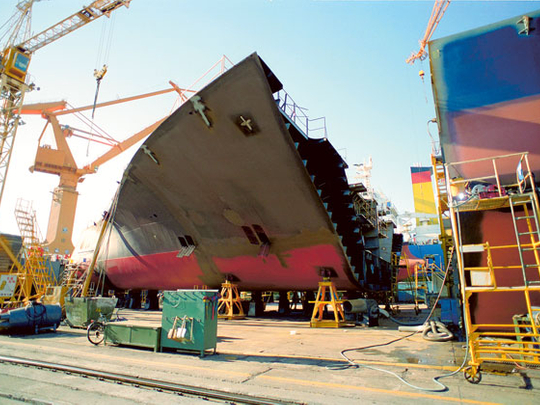
Ulsan, South Korea: Viewed from the South Korean port of Ulsan, home to the world’s largest shipbuilder Hyundai Heavy Industries, it is jackpot time on the international currency markets. Hyundai derives nearly all its revenues in dollars, a rising currency, while a big chunk of its spending is in weak euros — a sweet equation for its bottom line.
Machinations at the Federal Reserve and European Central Bank are reverberating across Asia through the currency markets, and for many companies, the impact is not as benevolent as at Hyundai. Makita, a Japanese power tool maker which generates 40 per cent of its sales in Europe, loses Y600 million (Dh18.6 million) of operating profit for every Y1 rise against the euro.
And even for shipbuilder Hyundai, conditions are far tougher than the currency market might suggest. The strengthening dollar has gone in tandem with a slump in the price of oil, leading vital oil industry clients to slash orders for vessels. Analysts say this fall in demand will easily outweigh any currency gains.
For many South Korean manufacturers the gain from a strong dollar has been largely offset by the won’s near-simultaneous rise against the euro, says Chanik Park, an equity strategist at Barclays. He estimates that Samsung Electronics and LG Electronics, as well as carmakers Hyundai Motor and Kia Motors, generate nearly 20 per cent of their sales in Europe.
Continued weakness in the euro would be a double problem for the carmakers in particular, he notes, because it would mean their European competitors would have “better pricing power”.
Since the end of August, the dollar, on a trade weighted basis, has strengthened 10 per cent against a basket of world currencies as investors bet on a rate rise by the Fed. Meanwhile, the euro has fallen sharply since early December, amid speculation about an imminent quantitative easing programme by the ECB.
Some individual Asian currencies have themselves been on a rollercoaster. The yen has slumped 30 per cent against the dollar since Japan’s prime minister Shinzo Abe launched his Abenomics programme, designed to banish deflation and stimulate growth.
The yen’s dramatic fall against the dollar has been widely seen as a boon for Japanese exporters, yet some are now complaining that the trend has gone too far after the market’s latest burst of dollar enthusiasm towards the end of 2014.
Sony says that each decline of 1 yen against the dollar cuts its operating profit by 3 billion yen, with any gain on foreign revenues more than outweighed by the increased costs of imported components for its smartphone and video game divisions.
Meanwhile, the electronics group Sharp says that it is seeing an increasingly negative impact from the yen’s decline, because it cuts into the profit from air purifiers and refrigerators that are produced abroad and sold in Japan. “The weaker yen is becoming tougher for us,” says Kozo Takahashi, Sharp’s chief executive.
South Korea’s government has not resorted to the aggressively reflationary policies of Abe, and the won is still stronger against the dollar than it was for much of the past six years, even after a decline of 8 per cent since August 31 last year.
A rising dollar also has implications for some Asian companies that have used the dollar-denominated market to borrow heavily in the past year. Those based in countries like Indonesia, Malaysia and Thailand — whose currencies have weakened as the dollar has strengthened — are likely to find it more expensive to service their debt.
“Where I do see a particularly vulnerable set of issuers is in commodity-based economies, and in part the subinvestment grade issuers, including resource-based issuers from Southeast Asia,” said Shankar Narayanaswamy, head of credit strategy and financials at Standard Chartered in Singapore.
Total dollar-denominated syndicated loan volume in Asia, excluding Japan, rose by 13 per cent over the previous year’s figure to $523 billion (Dh1.9 billion), according to Thomson Reuters. The number of deals rose to 1,650 from 1,289.
Most of that was by Chinese borrowers, which accounted for 27 per cent of the total, followed by Australia and then Southeast Asia, where volume reached $89 billion, also up by 13 per cent on the year.
Narayanaswamy said that for the most part across Asia the timeline of maturities of bonds meant that most borrowers would not face redemptions for a further two years. “We don’t have too many maturities especially from high-yield [borrowers] in 2015 but probably from 2017 on you will see a lot of maturities,” he said.-
In addition, most Chinese companies — with the exception of property companies — will be shielded by the resilience of the local currency, the renminbi or yuan, bankers said. The currency has traded within a relatively narrow range over the course of the last year.
That protection is likely to apply to the corporate bond market as well. Investment grade companies in Asia, excluding Japan, tapped the corporate bond markets to the tune of $593.7 billion, compared with $472 billion the previous year, according to Dealogic.
“For China and investment-grade issuers I don’t really see the strengthening dollar as a deterrent to the bond markets,” said Devesh Ashra, head of Asia debt capital markets syndicate at Bank of America Merrill Lynch.
While a relatively strong renminbi was “not a perfect hedge” for such companies nonetheless “given the strength of the currency and in spite of the [slower] economic outlook this [the dollar] should be a secondary issue for Chinese bond issuers”, he added.
— Financial Times












